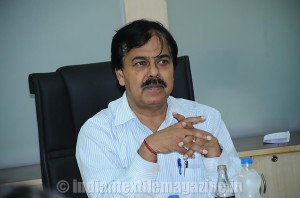Gujarat attracts additional investments in over 1.2 million spindles
Fifteen months into the announcement of its textile policy, Gujarat has been able to attract investments in over 1.2 million spindles which have either been commissioned or are in the process of being installed.

The Gujarat textile policy aims at installing around 2.5 million spindles by 2017-18 and taking the number of spindles installed from the current 1.2 million to 3.7 million spindles by 2017-18.
Apart from this, thanks to the new textile policy, the State has also been able to attract investments in other segments of the textile sector like weaving, knitting, fabric processing, apparel manufacturing and the burgeoning technical textiles segment.
“The main purpose behind the policy is to add value to the cotton that is produced in the State and also provide a thrust to the labour-intensive apparel manufacturing sector and also the technical textile sector,” Dr. Chandan Chatterjee, Director at the Center for Entrepreneurship Development, a Gujarat Government agency, explains to The Textile Magazine.
“Besides, the new policy will also target technology upgradation, specifically in weaving and fabric processing segments. Interestingly Gujarat is the largest manufacturer of weaving and processing machinery in the country. The recent announcement of the capital goods policy with its focus on textile machinery by the Union Ministry of Heavy Engineering is expected to give further boost to the textile machinery sector in Gujarat,” he adds.
As per the latest statistics, there are around 700,000 weaving looms operating in Gujarat, out of which 25 per cent are shuttleless, approximately 600 medium & large, 2,000 small & hand fabric processing units, and around 1,000 technical textile units, including converting units.
Dr. Chatterjee observes: “The Gujarat Textile Policy is not only targeted at the spinning segment, but is a holistic and an integrated policy. However, we also expect that the investments in spinning will act as a driving force and a force multiplier for investments in other segments like knitting, weaving, processing, apparel manufacturing, etc.”
Investors have also committed investments in the knitting sector too, which till date was not as strong as in, say, Tirupur or Ludhiana. The existing fabric process houses too have begun upgrading their technology so as to be able to process knitted fabrics too.
Dr. Chatterjee notes with satisfaction that the technical textiles segment in the State will also see more than 200 more units being set up after the textile policy announcement. Investments have flowed into high-tech areas like glass fibre fabric, space application fabrics, automobile interiors, etc.
He feels that on an investment of Rs. 1 crore, 9-10 jobs can be added in spinning, while 100-150 jobs can be added in apparel manufacturing, which can again employ women workforce. For this reason, the textile policy also aims to provide added thrust to the apparel sector which has the potential to provide large-scale employment. The new labour policy, being formulated will have a specific chapter to address the specific concerns of the labour-intensive garment sector.
Dr. Chatterjee suggests that entrepreneurs investing in garment manufacturing should go in for stitching of high-value products which will yield them better returns and in turn help them pay better salaries, at par with those paid by other industries. This will help the industry attract local labour and overcome recurrent labour shortage, besides skill development already gathering momentum under the new textile policy.
The Union Ministry of Textiles has initiated a scheme whereby it provides funds to the State Governments, which will impart training skills to labour in the textile and apparel industries. The Gujarat Government which is supposed to contribute around 25 per cent of the funds has provided matching contribution for the Union Textiles Ministry’s skill development program.
According to Dr. Chatterjee, a five-year target has been set for providing textile and apparel industry-specific skills to around two lakh people. In the first year, around 25,000 people will be skilled, the second year 35,000, and so on. They will begin with skilling people for the spinning sector as maximum investments have been committed to this segment and will gradually or concurrently also train people in other segments.
Most of the training activity will be done in the plant itself, and a part of the will be imparted at the training centres set up in the GIDC Industrial Parks across the State. Most of them have been equipped with CNC machines, lathe machines, etc., and the complete system will be managed by the Government.
The first target of the skill development program would be the youth ready to enter the employment sector, who, according to Mr. Chatterjee, need skills the most, while skills would also be upgraded for those already working in the sector.
He further says that almost 25 per cent of labour employed in Gujarat is dominated by the textile and apparel sector. This is the reason for the special focus on skill development in the industry. With new skills acquired, the worker will be able to handle more work loads and, in turn, generate more income, which will help the sector attract and retain workers.
The Gujarat Government has also set up a CSR cell, with its major focus on imparting skills. With its support, the Gujarat Government is going further ahead by providing transportation, food and shelter to the trainees. The cell will help manage these additional activities.
Mr. Chatterjee discloses: “The scheme will also encourage companies to pay these trainees a stipend as these people are coming to the training program by forsaking other paying or employment opportunities, and this holistic approach will go a long way in making the skill development program a success.”
When quizzed why investors prefer Gujarat, he asserts: “Security of their investment, a good labour-friendly environment and commitment of the State Government are the three main decisive factors while deciding to invest in Gujarat”